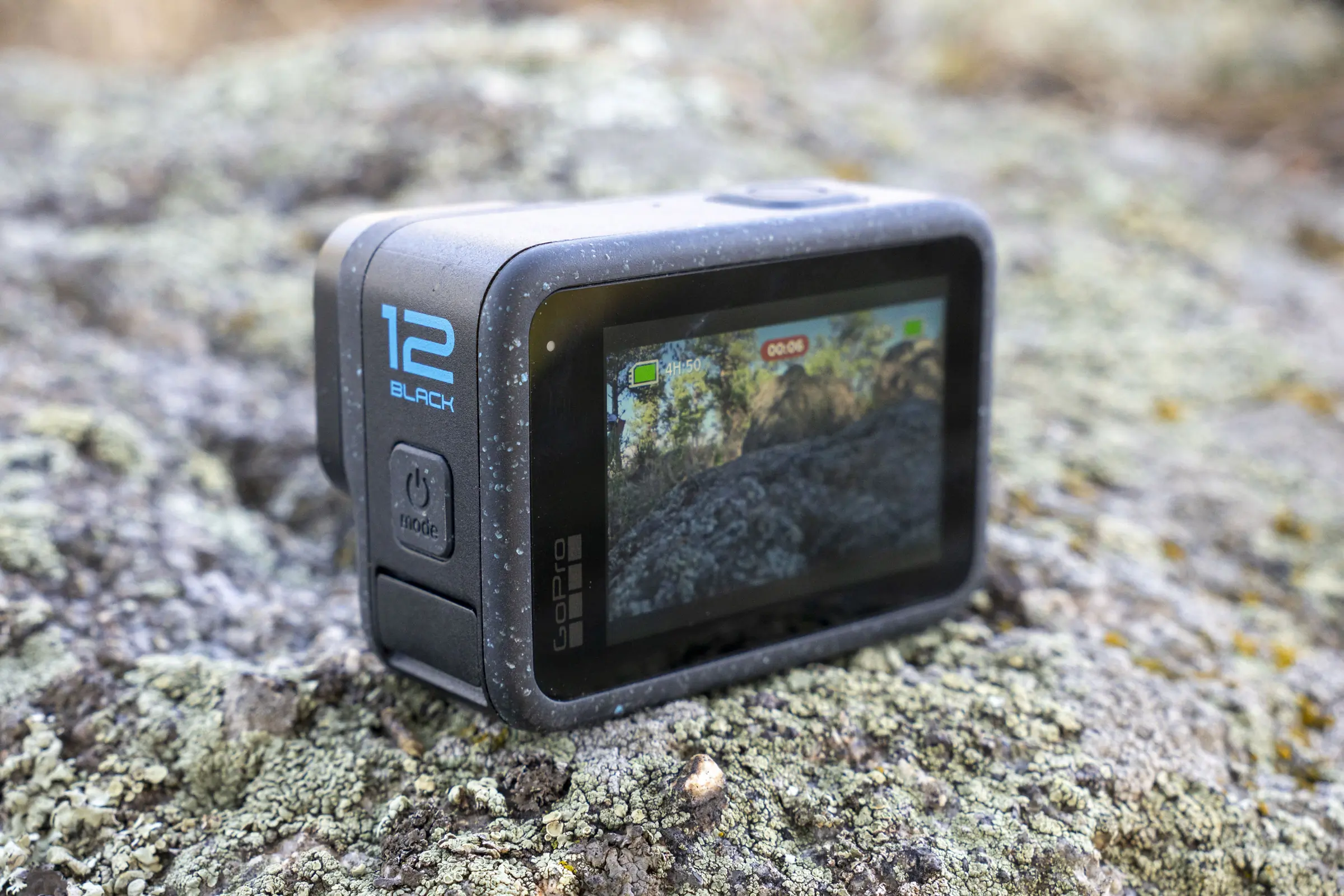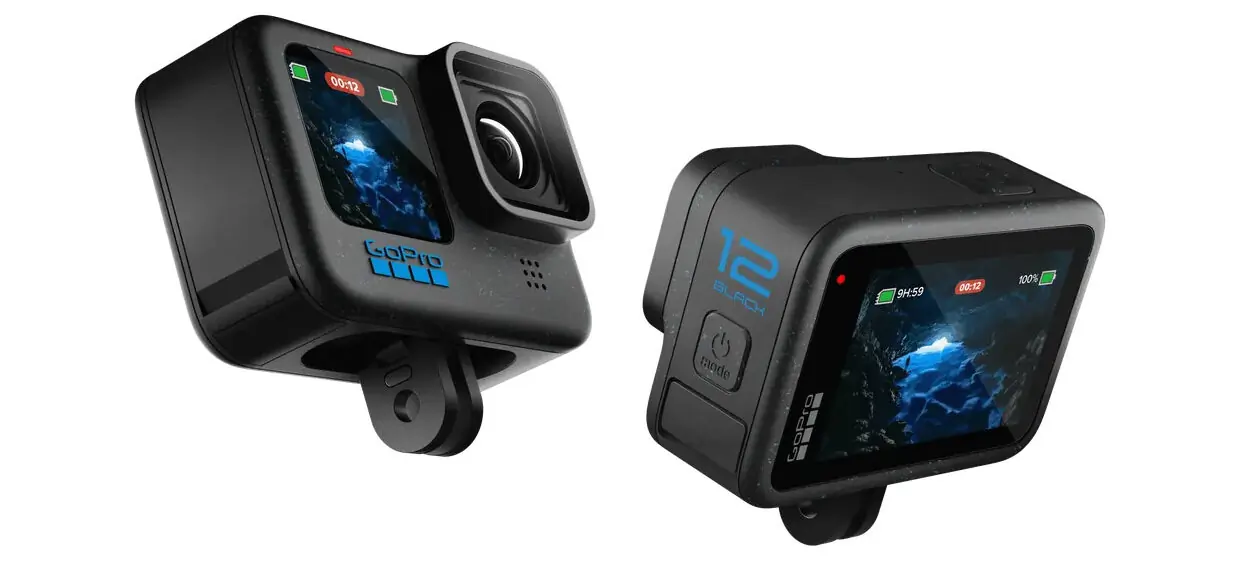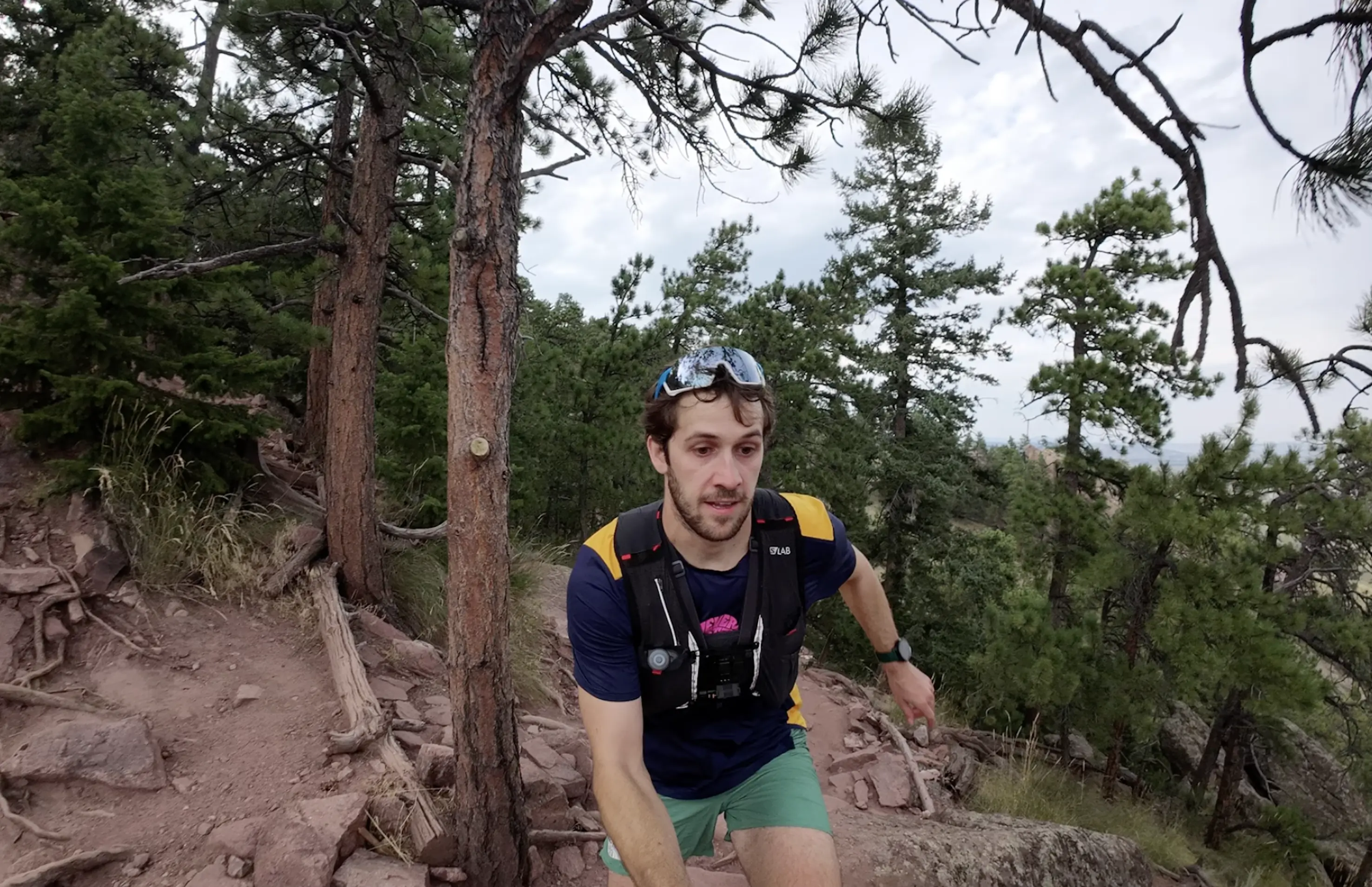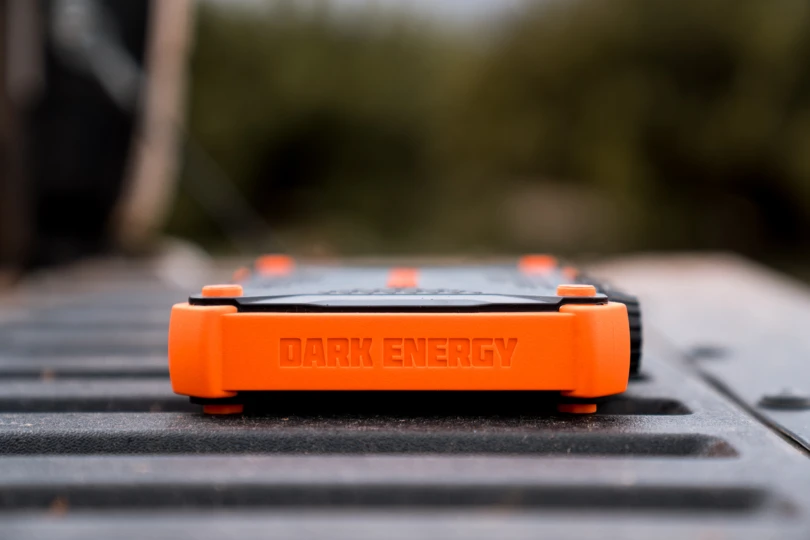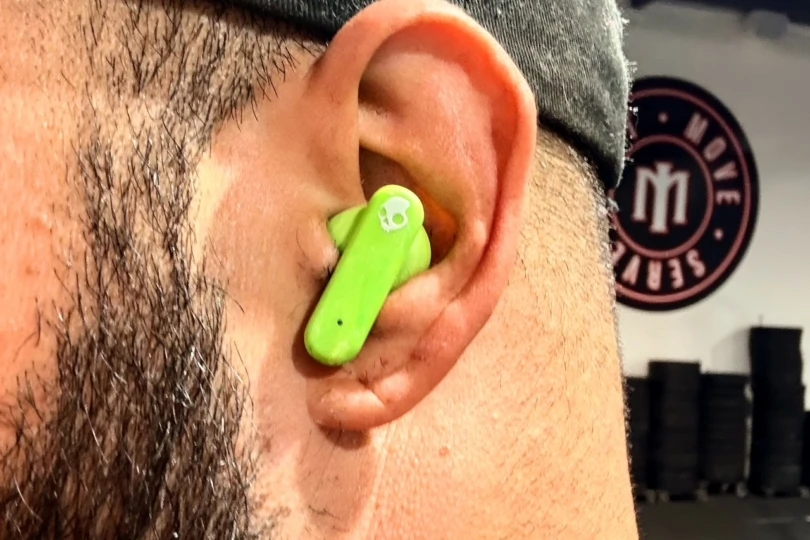Kelsey (my partner) just dunked her head in an especially swift-flowing Clear Creek in Golden, Colo. I wanted a cool slow-motion shot of her doing an epic hair flip, so I set the frames per second (fps) to 120 and pulled the GoPro HERO12 in close. She emerged from the water, hair flying over her head, but her hair-flipping dreams don’t come true. Her mass of hair lands with a splat on her face, both of us laughing at how silly the footage must be.
When I got back to the car after our river outing with the GoPro HERO12, I wanted to show her the footage of her hair flip. I opened the Quik App, GoPro’s adjoining app, found my camera, and started transferring footage. The HERO12 uses its own Wi-Fi to pair with the phone and send over the footage.
Minutes later, we were able to watch the slow-motion footage of her failed hair flip in the car, laughing as we relived the moment. This Wi-Fi transfer feature is not new for the HERO12 — but it’s easily one of the best features of the GoPro.

In short: I rigorously tested the GoPro HERO12 over the past week, mountain biking, rock climbing, swimming, and cliff jumping with the small but mighty camera. Despite it having new features like the Lens Mod 2.0, new HDR mode, and a longer-lasting battery, the feature that impressed me the most was how far GoPro has come in terms of user-friendliness with its Quik App, which is a part of the GoPro subscription.
GoPro HERO12 Black Video Review
- Battery: Removable 1,720mAh lithium-ion Enduro
- Rear touchscreen: 2.27” color LCD
- Front screen: 1.4” color LCD
- Waterproof: Up to 33 ft.
- Sensor: 8:7
- Live streaming: 1080p
- Photo resolution: 27MP in photo mode, 24.7MP out of video
- Peak settings: 5.3K 60 fps, 4K 120 fps, 2.7K 240 fps
- Dimensions: 71.8 W x 50.8 H x 33.6 D (mm)
- Maximum video bit rate: Up to 120 Mbps
- Video stabilization: HyperSmooth 6.0
- Field of view: Max lens mod 2.0 -177 degrees (151 degrees without lens)
- Price: $399
Pros
- Vivid color capture quality
- Very stable footage
- Editing software
Cons
- Same video quality as HERO11
- Lens mod 2.0 is expensive and warps footage
- Cloud uploads take forever
GoPro HERO12 Black Review

What’s New This Year: Max Lens Mod 2.0
Most notably, the GoPro HERO12 updates include the Max Lens Mod 2.0, a high-dynamic range mode for photo and video, and longer-lasting battery performance.
The Max Lens Mod 2.0 is a $99 lens that screws on. It enables a 177-degree field of view and can shoot up to 4K at 60 fps. This lens does give a bigger field of view, but the resulting footage has a fish-eye feel.
Also, GoPro made the Max Lens Mod 2.0 more scratch-resistant. I didn’t encounter scratches in my test, but because the lens extends so far out from the camera, I could see that being a nice improvement.
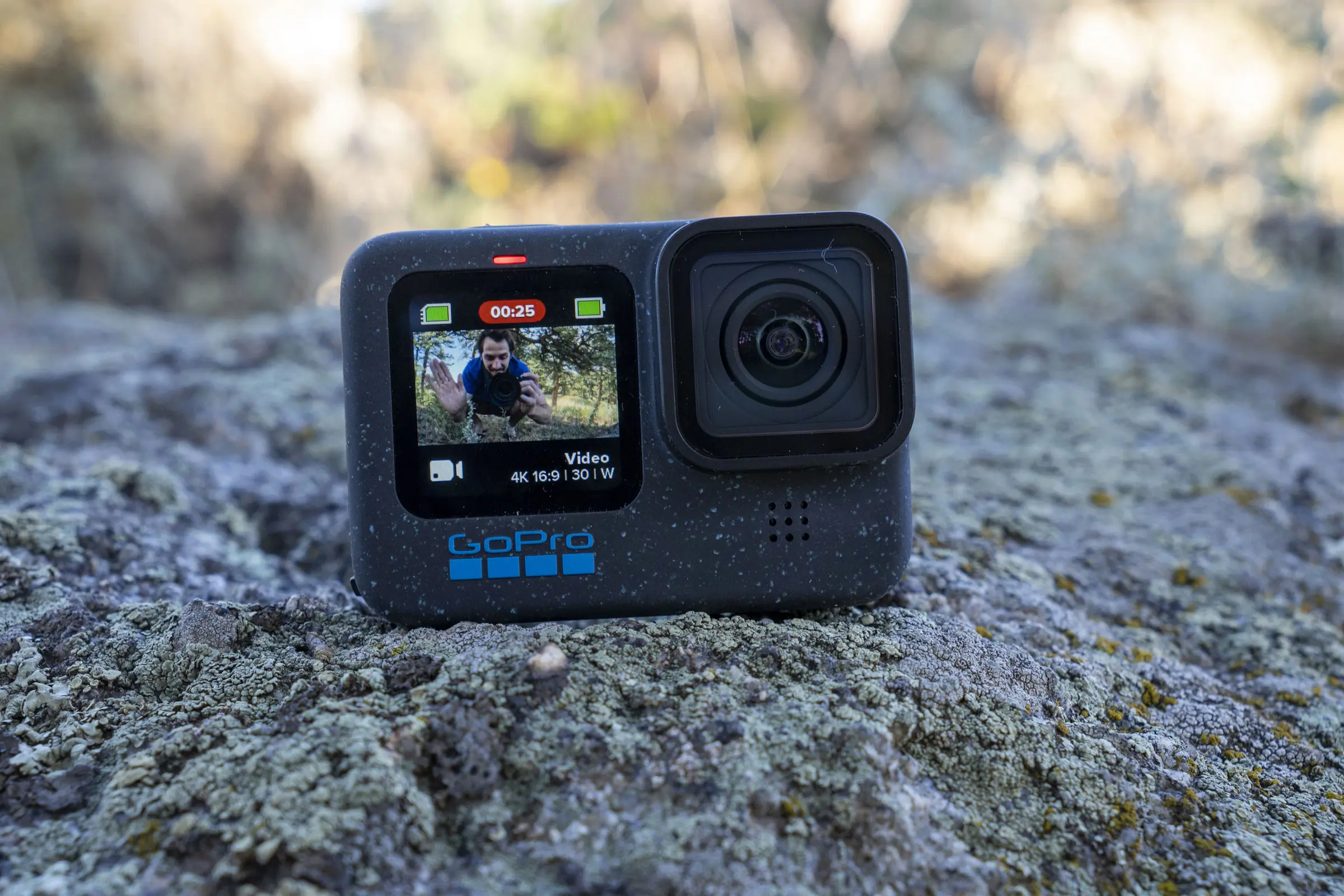



The HDR, high dynamic range, mode is a selectable option in the menu and decreases the intensity of highlights, while improving quality in shadows. Before a feature like this was available in cameras, to achieve an HDR image, you would have to shoot an underexposed and overexposed photo and overlay the images so that the resulting image has detail throughout all the colors in the photo.
This feature on the HERO12 works but is often subtle.
The HERO12 uses the same battery as the HERO11. But the brand improved the thermal efficiency of the HERO12, so it doesn’t overheat as quickly as the HERO11 when shooting at high framerate and in high-quality modes like 4K 120 fps or 5.3K 60 fps. The improvements to all but the highest quality modes are marginal, but it does offer double the runtime for continuous shooting.




Also new for the HERO12 is wireless audio connectivity for Bluetooth headphones or microphones, a GP-Log setting that allows filmmakers more creative liberty when color grading in post-production, the ability to wirelessly timecode sync multiple cameras, an update to stabilization with HyperSmooth 6.0, and a vertical capture mode that delivers a 9:16 aspect ratio.
There are some improvements to the HERO12, but when I compare the footage to the HERO11 or the DJI Osmo Action 4 that I recently reviewed, the videos look similar.
In the Field: MTB, Climbing Test
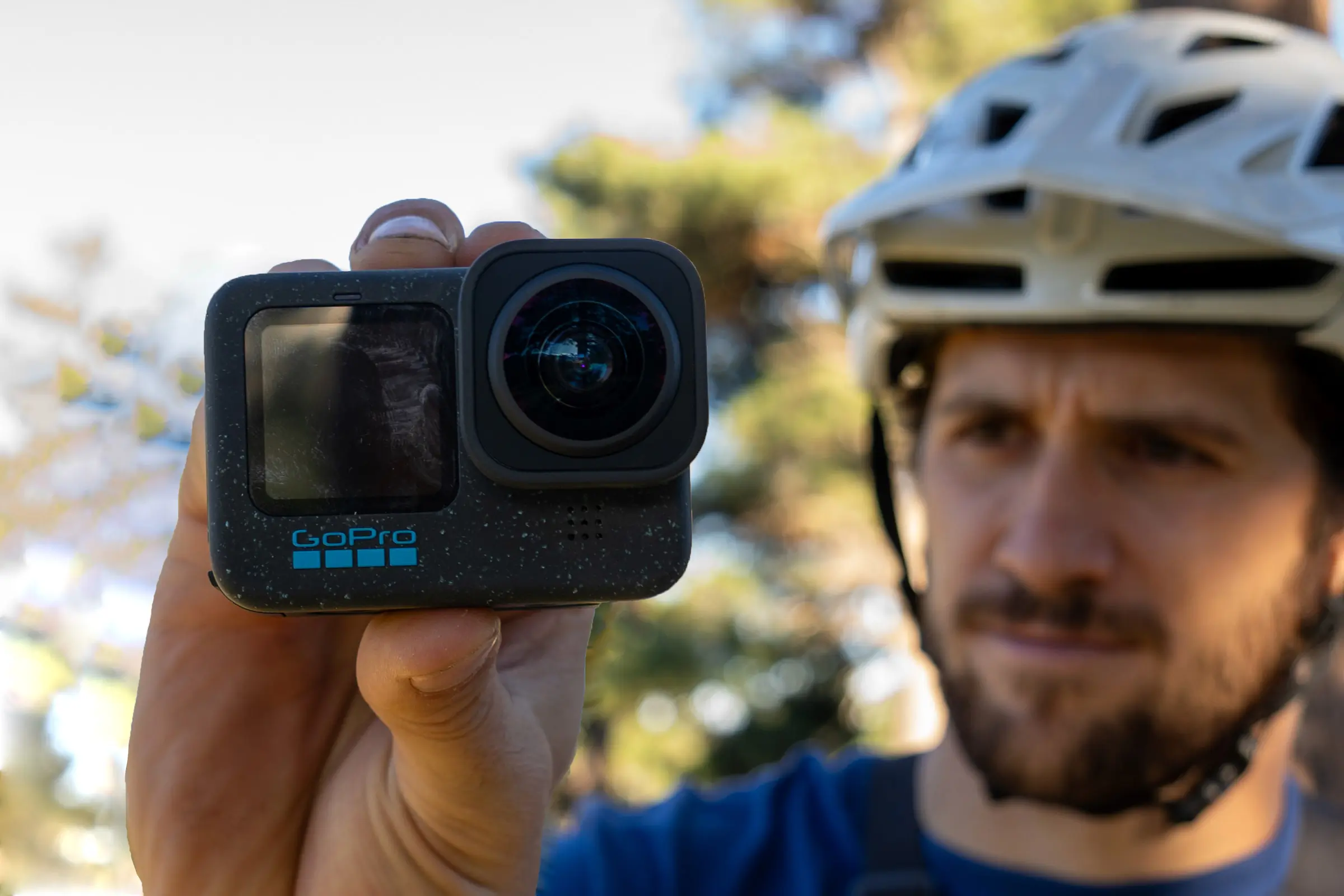



When I went mountain biking, I tested the Max Lens Mod 2.0. The field of view is definitely wider, allowing you to get more in the shot, but when viewing the footage in a standard 16:9 aspect ratio, there’s quite a lot of warping on the edges of the footage. It kind of looks like you’re on the top of a sphere.
I could see the Max Lens Mod 2.0 being most useful for vertical-video-oriented creators, because the warping mostly happens on the edges of wide video. So, the Lens Mod allows a lot more in frame for the narrow 9:16 aspect ratio. Otherwise, the GoPro already offers pretty wide fields of view, with Hyperview enabling 151 degrees of view.
Hyperview tends to be too large of a field of view for my taste, and I stick to SuperView. When paired with HyperSmooth, it enables 138 degrees of view.
As for HDR, I tested this feature when rock climbing and mountain biking. I climbed a shaded route with the background and horizon in the sun. It definitely cut down on the harsh light in the background and caused the blue sky to pop a bit more. It didn’t do much to enhance shadows, but I was fairly pleased with the highlight performance.
When I tested this feature with a less dramatic lighting example than my climbing test, it worked subtly. I had to squint my eyes in the footage to see if HDR was truly on in some of my frames when mountain biking in direct sunlight.
Battery Life, Overheating
And, as for battery life, the GoPro already had impressive battery life, allowing me to record most of all day on the same battery. Take my recent video on the Lutsen 99er as an example. I recorded the majority of my 9-hour bike ride with a single GoPro HERO11 battery. I didn’t record every moment of the bike ride, but I was recording a lot of scenes that day.
The improvement to the battery is best on 5.3K 60 fps and 4K 120 fps modes. Every other recording mode only sees 10- or 20-minute improvements to the battery.
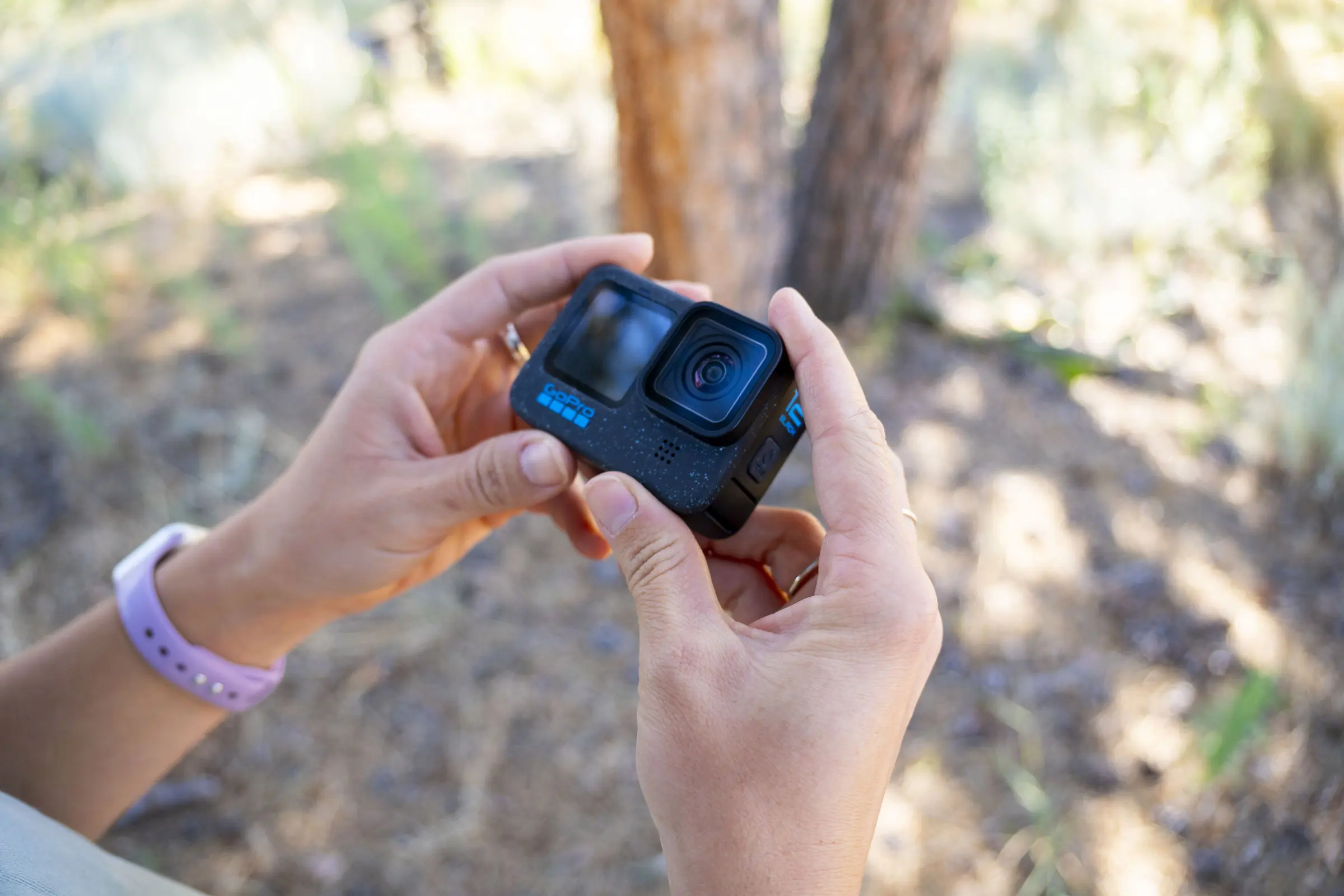



Personally, I never encountered overheating issues when recording on my GoPro HERO11. If I’m recording super slow-motion footage at 120 fps, I try to limit how long I record as hard as possible because 120 fps results in a huge file size.
I typically only need a sliver of a moment for slow-motion replay. But, if you’re recording time lapses or hyperlapses at the absolute highest settings, the HERO12 offers improvement to battery life.
Shooting, Editing
I also tested the vertical content mode and 9:16 aspect ratio. The GoPro HERO11 offered the same field of view when shooting on the HERO11’s 8:7 aspect ratio. With the Hero 11, however, you would have to edit the footage to 9:16 in post. The HERO12 saves you some time because the footage captured is already 9:16.
I didn’t find the most use out of the GP-Log color grading, partly because I think the GoPro does a pretty impressive job of coloring things itself. However, if you want more creative liberty over how your footage is colored, this feature will offer more ownership in color grading.
The timecode sync feature works great if you don’t want to deal with the hassle of going into your GoPro’s settings and adjusting the timecode every time you shoot. Previously, to ensure the footage from multiple camera sources is lined up while editing, you would have to ensure each camera is set to the same timecode.
Now, with the HERO12, you only have to scan a QR code with each GoPro, and it automatically syncs the timecode. So, the timecode sync feature will save you time upfront.
After testing the GoPro 12 out, I wasn’t that impressed with the footage and upgrades when compared to the HERO11. The footage from the HERO12 is on par with the 11 and the DJI Osmo Action 4, released in the summer of 2023 (review linked above).
But along with the HERO12 sample I tested, I also used GoPro’s subscription service and editing app. This is where GoPro blew me away with how far the brand has come to make content creation easy.
GoPro HERO12: Quik App and Subscription
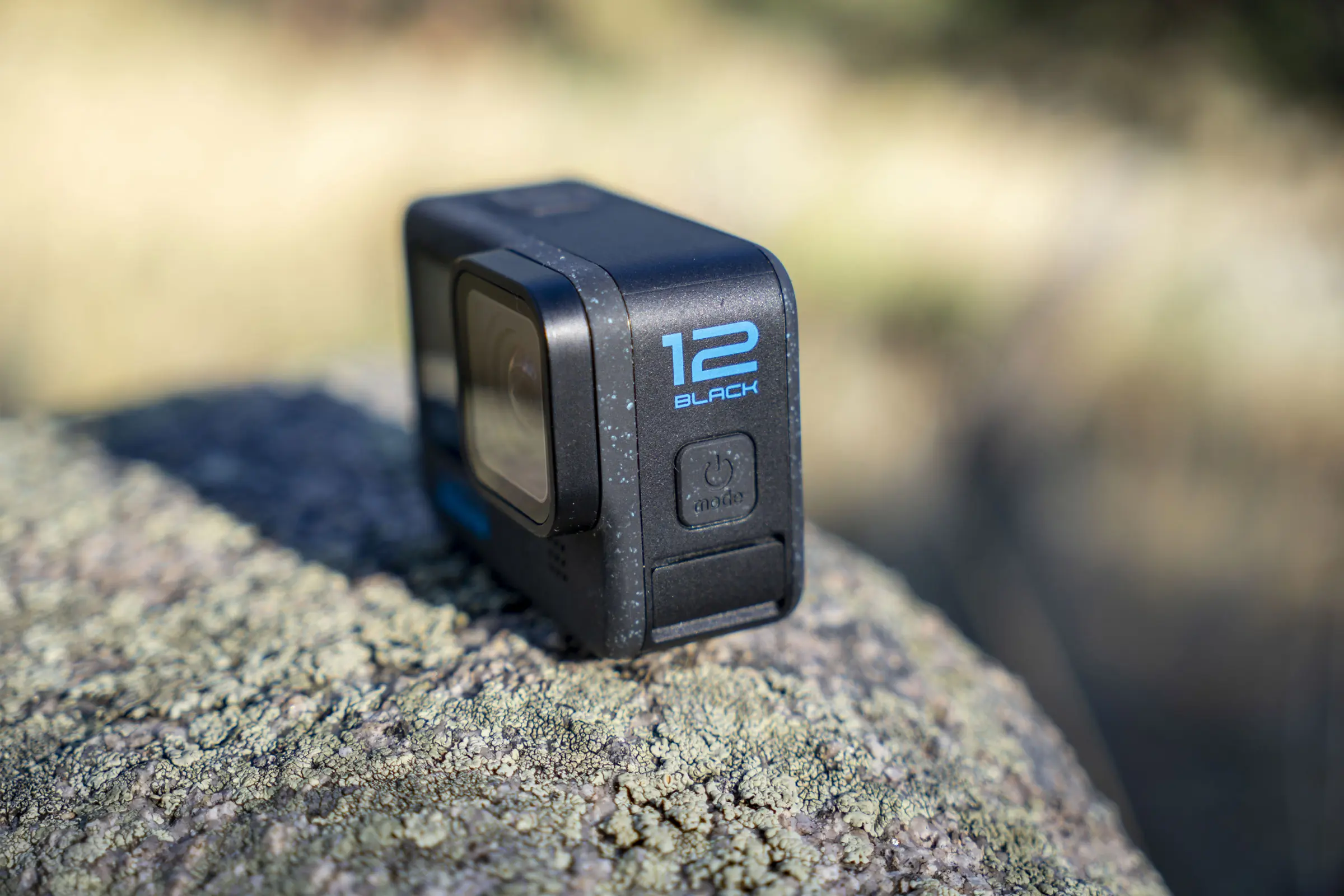



The Quik app and subscription model are not new for the HERO12. The brand will release desktop versions of its editing software for Mac in 2023 and PC in 2024.
You can use the app if you have a GoPro HERO10 or HERO11, or any version of GoPro. So, while it isn’t necessarily new, the brand has steadily improved its user-friendliness. When I used it over the past 2 weeks, I couldn’t believe how much more I enjoyed using the GoPro.
The subscription costs $25 for your first year and $50 each year after that. Along with full access to the editing app, you also get discounts on GoPro’s store and free camera replacement if you damage or lose your GoPro.
With the Quik app, I can send footage from my GoPro HERO12 to my phone within seconds. The GoPro’s Wi-Fi connectivity accomplishes this, which means you don’t need cell service to use it. I tested this several times in areas without cell service, and it worked.
Once the footage loads in the app, I can quickly look at clips of what I just shot. It only took minutes to transfer 5 gigs of footage from an afternoon of swimming. I then could replay some of our favorite moments, set the aspect ratio to vertical, and implement slow motion. I didn’t need to go home, upload the footage to my computer, and scrub through tons of footage to find the right moment.
This was easily my favorite feature of the GoPro Quik App, and I used it repeatedly in my testing. When I was out climbing, I perfectly caught the end of the rope after I had finished a climb while recording with the GoPro. I uploaded the footage to my phone, cut out a 10-second clip, and sent it to another one of my climbing friends so he could witness my rope-catching greatness.
I am not a super user of the app, yet I was able to cut short, 10-second clips in mere minutes after the recording on my GoPro stopped. Transferring the files to my phone, finding the clip, and editing takes little time. And I felt comfortable using the app after only trying it out a few times.
In using the app, I found it best setup for shorter-format editing. I still prefer dedicated editing software on my laptop when editing longer videos, like the review video above.
Further, the subscription enables unlimited cloud storage. This is especially handy because 4K footage or 5.3K takes up a ton of space on your laptop.
Transferring video from the GoPro to my phone, as I did in my examples above, does not incorporate the cloud. To upload to the cloud, I have to select that option in the app, which starts the transfer. Uploading to the cloud takes a long time, so I started cloud uploads before bed and had them run overnight.
Who Is the GoPro HERO12 For?
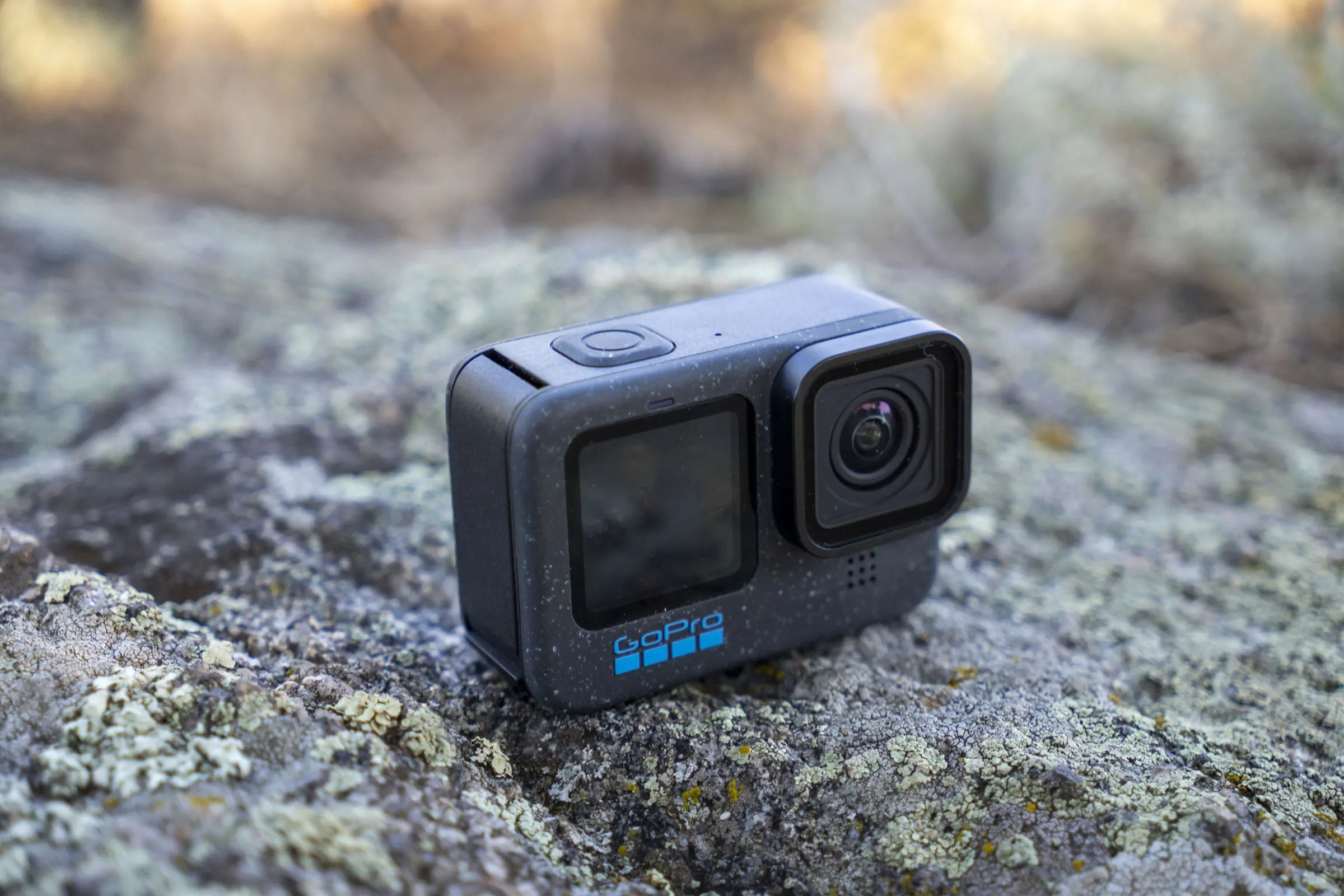



When comparing footage between the latest GoPros and action cameras, I struggle to find major differences from one camera to the other. But in analyzing footage from one year to the next, you miss out on the major strides GoPro has taken with its user accessibility improvements.
Sure, it’s another subscription to add to the growing pile of subscription services we all pay for, but I think using the app enables users to take out their GoPro much more frequently.
Because the GoPro app is compatible with earlier iterations of GoPros, if you are pleased with the footage of a GoPro HERO10 or HERO11, I would suggest sticking with those models. But if you’re new to GoPro or have taken a GoPro hiatus, the 12 and adjoining software might be worth checking out because the user experience now is that much better.
